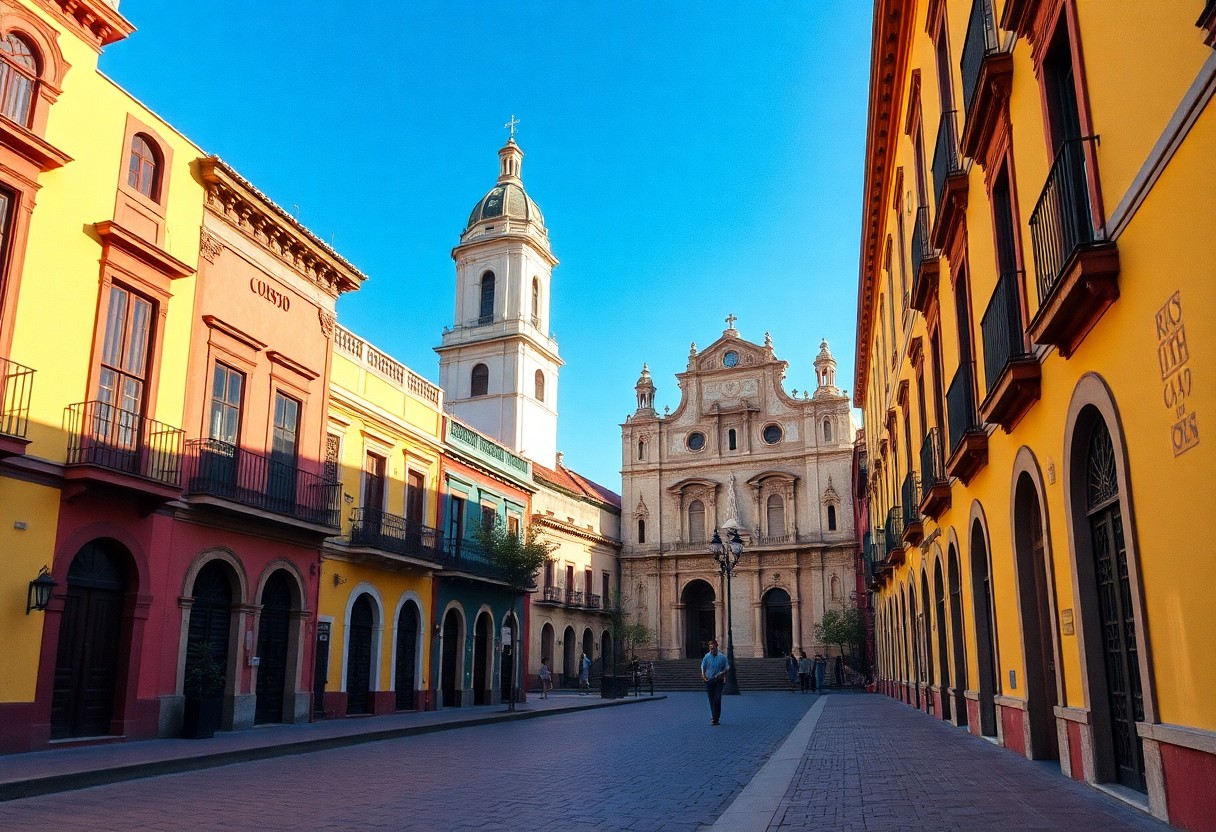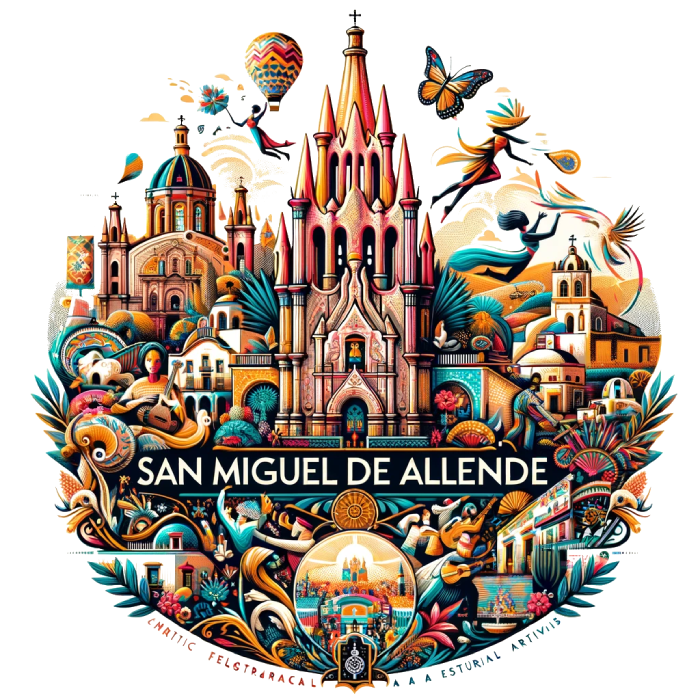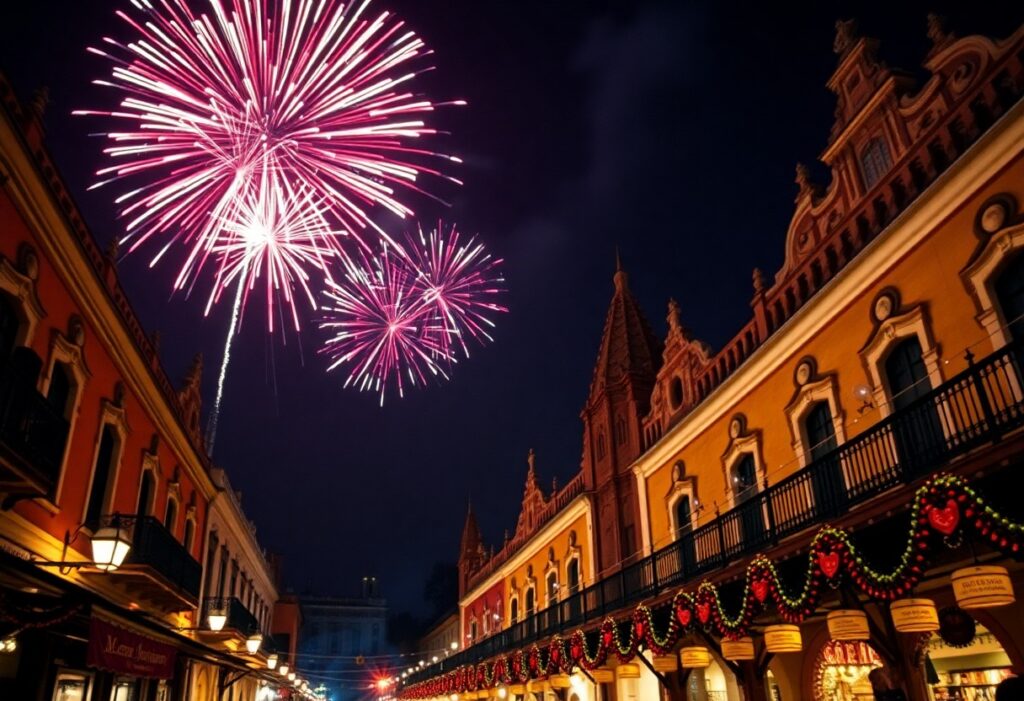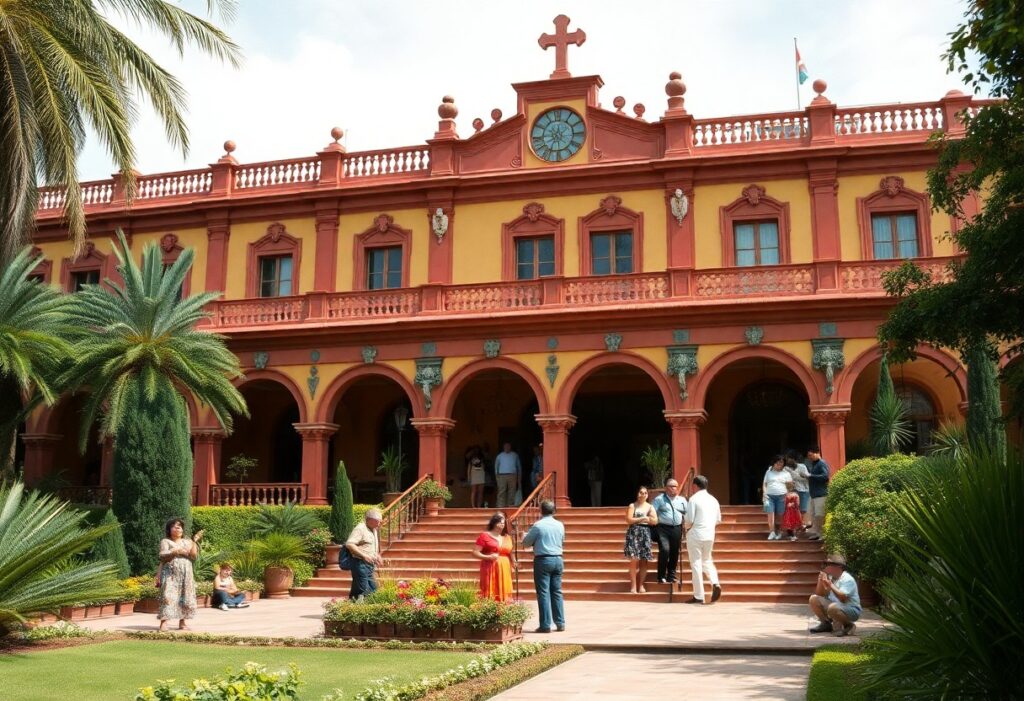This colonial gem nestled in Mexico’s heartland offers architectural splendor unlike any other destination. San Miguel de Allende’s urban landscape captivates visitors with its meticulously preserved Spanish colonial structures. It features vibrant facades, ornate iron balconies, and intricate stonework that transport you through centuries of design history. You’ll discover a UNESCO World Heritage site where every street corner reveals stunning architectural details that blend indigenous craftsmanship with European influences, creating a visual narrative that makes San Miguel de Allende a true architectural marvel. Your exploration will unveil why this city is a testament to Mexico’s rich cultural and design heritage.
Types of Architectural Styles in San Miguel de Allende
Before exploring San Miguel de Allende’s architectural landscape, you’ll discover a rich tapestry of styles that reflect its historical complexity. The city’s architectural heritage includes:
- Spanish Colonial influences
- Baroque elements
- Neoclassical designs
- Contemporary interpretations
Assume that each architectural style tells a unique story of cultural transformation.
| Architectural Style | Key Characteristics |
|---|---|
| Spanish Colonial | Thick walls, internal courtyards |
| Baroque | Ornate decorations, intricate details |
| Neoclassical | Symmetrical designs, classical proportions |
| Contemporary | Modern interpretations, sustainable elements |
| Hybrid Styles | Blended architectural approaches |
Spanish Baroque Influence
Little known to many, the Spanish Baroque style profoundly shaped San Miguel’s architectural identity. The region’s rich colonial heritage is showcased in elaborate facades, intricate stone carvings, and dramatic architectural elements.
Neoclassical Architecture
Neoclassical architecture emerged as a refined counterpoint to earlier ornate styles, introducing elegant symmetry and precise geometric forms to San Miguel’s urban landscape.
Architecture in San Miguel’s Neoclassical period represented a sophisticated transformation characterized by balanced proportions, clean lines, and a deliberate return to classical Greek and Roman design principles. These structures emphasized rational design and mathematical precision.
Contemporary Interpretations
Influence from global architectural trends has seamlessly integrated with San Miguel’s traditional styles, creating innovative design approaches that respect historical contexts.
Types of contemporary architectural interpretations in San Miguel blend modern sustainability practices with traditional aesthetic principles. You’ll discover how architects respectfully incorporate cutting-edge technologies while maintaining the city’s unique visual character.
Iconic Structures in San Miguel de Allende
San Miguel de Allende clearly boasts an architectural landscape that captivates visitors with its extraordinary blend of colonial and indigenous design. You’ll find a remarkable collection of historic buildings that showcase the city’s unique architectural heritage, each telling a story of cultural fusion and artistic expression. These iconic landmarks represent more than mere buildings; they are living testimonials to the city’s rich historical narrative.
The Parroquia de San Miguel Arcángel
Some consider this pink neo-Gothic church the most photographed landmark in San Miguel. Its dramatic pink spires and intricate facade dominate the city’s central plaza. The structure, designed by Indigenous stonemason Zeferino Gutiérrez, represents a stunning example of local architectural creativity that blends European and Mexican design elements.
The Allende Institute
Structures like the Allende Institute exemplify San Miguel’s commitment to cultural preservation. You’ll discover a beautiful colonial building now serving as an essential educational and cultural center, highlighting the city’s dedication to arts and heritage.
The Allende Institute’s rich history stands as a significant cultural landmark. Originally established as a military academy, it now hosts art exhibitions, workshops, and educational programs celebrating local and international artistic traditions. The building is a testament to San Miguel’s architectural elegance and historical importance.
Casa de la Cultura
The Casa de la Cultura is another architectural gem in San Miguel’s cultural landscape. This historic building provides a vibrant space for artistic expression, hosts numerous cultural events, and serves as a hub for local creative communities.
Casa de la Cultura represents more than just a building; it’s a living cultural institution. The space offers art classes, hosts exhibitions, and provides a platform for local and visiting artists to showcase their work. Its architectural design reflects the city’s commitment to preserving artistic traditions while creating dynamic spaces for contemporary creativity.

Key Elements of Colonial Buildings
To understand San Miguel de Allende’s architectural charm, you’ll want to explore the distinctive colonial building characteristics that define this UNESCO World Heritage site. These structures represent a harmonious blend of Spanish colonial and indigenous architectural traditions, showcasing intricate design elements that reflect the city’s rich historical narrative. You’ll notice how each building tells a story through its carefully crafted architectural details.
Facade Designs
Colonial facades in San Miguel de Allende are architectural masterpieces that capture your imagination. You’ll observe ornate stone carvings, elaborate doorways, and symmetrical designs that showcase the region’s baroque and neoclassical influences. These facades often feature intricate window treatments and decorative elements that highlight the exceptional craftsmanship of local artisans.
Courtyards and Gardens
Assuming you’re interested in interior spaces, you’ll find that courtyards are vital architectural elements in San Miguel’s colonial buildings. These interior spaces serve as tranquil retreats, providing natural light, ventilation, and a connection to nature. You’ll appreciate how these courtyards create a peaceful sanctuary within the bustling urban environment.
The Louver San Miguel de Allende courtyards are meticulously planned to maximize aesthetic and functional aspects. You’ll discover multi-level courtyards with intricate tile work, fountains, and lush vegetation that create a microclimate and serene outdoor living space. These architectural features reflect the region’s sophisticated approach to urban design and environmental adaptation.
Use of Color and Texture
Color and texture are fundamental design elements in San Miguel’s colonial architecture. Vibrant facades ranging from deep ochres to brilliant blues create a visually stunning urban landscape. These colors are decorative and serve practical purposes, reflecting sunlight and creating visual depth.
For instance, using local materials like stone, stucco, and handcrafted tiles contributes to the unique textural quality of San Miguel’s buildings. You’ll notice how these materials interact with light, creating subtle variations and adding visual complexity to the architectural surfaces. The intentional layering of colors and textures transforms each building into a work of art that reflects the city’s cultural heritage.
Historic Homes and Mansions
Unlike other colonial cities, San Miguel de Allende’s historic homes represent a stunning architectural preservation that captures your imagination. You’ll discover elegant mansions that showcase the city’s rich cultural heritage, with intricate facades and beautifully maintained interiors that transport you back to the colonial era. These residential structures reflect a unique blend of Spanish colonial and Mexican architectural styles, offering you a glimpse into the city’s sophisticated architectural narrative.
Notable Examples of Restored Homes
While exploring San Miguel de Allende, you’ll encounter meticulously restored homes that stand as living testaments to the city’s architectural legacy. Casa de la Cultura and Casa Allende are prime examples that you can visit, each showcasing exceptional restoration techniques that preserve the original architectural details and historical significance.
Architectural Features of Historic Mansions
Little details make San Miguel’s historic mansions genuinely remarkable. You’ll notice ornate wrought-iron balconies, colorful stone facades, and intricately carved wooden doors that define the city’s distinctive architectural character. These features reflect a rich architectural tradition that continues to captivate visitors and historians alike.
San Miguel de Allende’s Homes boast extraordinary architectural elements beyond surface aesthetics. You’ll find complex interior courtyards, elaborate tile work, and sophisticated architectural layouts that demonstrate the sophisticated design principles of colonial Mexican architecture. These structural elements provide functional living spaces and represent a profound cultural and historical narrative.
Preservation Efforts and Challenges
One of the most significant aspects of San Miguel’s architectural heritage is the ongoing preservation and restoration efforts. Local organizations and government initiatives work diligently to maintain the city’s historical architectural integrity, protecting these valuable structures from potential deterioration.
Preserving San Miguel’s historic homes involves complex challenges and innovative strategies. You’ll appreciate how local experts balance historical authenticity with modern conservation techniques, ensuring these architectural treasures remain vibrant and functional while maintaining their original character. Community involvement and strict architectural guidelines are critical in protecting the city’s unique architectural landscape.
Walking Tours: Exploring the Cobblestone Streets
Despite the challenging terrain, San Miguel de Allende’s cobblestone streets offer an enchanting journey through architectural history. You’ll navigate narrow pathways that wind between colorful colonial buildings, each step revealing stunning architectural details. The uneven stones beneath your feet tell stories of centuries past, inviting you to explore the city’s rich cultural landscape at a leisurely pace.
Recommended Walking Routes
Some of the most captivating walking routes in San Miguel de Allende wind through the historic center, connecting significant landmarks like the Parroquia de San Miguel Arcángel and the Jardín Principal. You’ll discover hidden plazas, charming courtyards, and breathtaking vistas that showcase the city’s unique architectural heritage.
Tips for Enjoying the Scenery
Recommended strategies for maximizing your walking tour experience include:
- Wear comfortable walking shoes
- Bring a water bottle and sunscreen
- Carry a lightweight camera
- Plan your route in advance
Perceiving the architectural details requires a slow, mindful approach to exploration.
Unique Callejóns and Their Stories
San Miguel’s narrow alleyways have been silent witnesses to the city’s evolving cultural narrative for centuries. These intimate passageways connect different parts of the city, offering glimpses into local life and architectural traditions.
Each callejón presents a unique character, and you’ll discover intricate architectural details, hidden courtyards, and unexpected artistic expressions. The narrow passages reveal layers of historical significance, from colonial-era design to contemporary urban life, making each step a journey through time and culture.

Modern Architecture in San Miguel de Allende
Not all architectural developments in San Miguel de Allende are rooted in colonial history. Modern architecture has gradually emerged, offering a fascinating glimpse into contemporary design approaches that respect the city’s historical essence while introducing innovative spatial concepts.
Blending Old and New: Contemporary Design
Now, you’ll discover how architects in San Miguel seamlessly integrate modern architectural elements with the city’s traditional aesthetic. They carefully design structures that complement the existing urban fabric, using materials and techniques that honor the historical context while providing functional, elegant spaces.
Noteworthy Modern Buildings
There’s a growing collection of contemporary architectural gems in San Miguel that you should explore. These buildings showcase innovative design principles, utilizing clean lines, sustainable materials, and minimalist aesthetics that contrast beautifully with the city’s historic surroundings.
Miguel de Allende has witnessed several significant modern architectural projects demonstrating the city’s evolving design landscape. Cutting-edge residential complexes, cultural centers, and public spaces have emerged, each telling a unique story of architectural innovation while maintaining a respectful dialogue with the city’s heritage.
Community Reactions to Modern Developments
While some residents initially expressed skepticism, many now appreciate how modern architecture adds dynamism to San Miguel’s urban environment. Contemporary design that thoughtfully integrates with the city’s historic character is growing in acceptance.
The community has gradually embraced these architectural transformations, recognizing that thoughtful, modern design can coexist harmoniously with traditional aesthetics. Architects and residents collaborate to ensure new developments enhance rather than disrupt the city’s unique architectural identity.
Decorating Traditional Homes
San Miguel de Allende’s homes have reflected a rich architectural heritage that blends Spanish colonial influences with local craftsmanship for centuries. These residences are adorned with intricate details, vibrant colors, and handcrafted elements that tell stories of cultural fusion and artistic expression.
Elements of Colonial Interior Design
The interiors of San Miguel’s traditional homes showcase a stunning array of design elements that capture the essence of colonial aesthetics. You’ll discover hand-painted tiles, wrought-iron details, exposed wooden beams, and thick, whitewashed walls that create a sense of timeless elegance and historical depth.
Contemporary Adaptations
To modernize traditional spaces, San Miguel designers skillfully blend historical elements with contemporary design. You’ll see innovative approaches that preserve original architectural features while introducing modern comfort and sleek aesthetics.
Homes in San Miguel de Allende are experiencing a creative renaissance. International designers and local artisans collaborate to reimagine interior spaces. These transformations respect the city’s architectural heritage while introducing global design trends, creating unique living environments that honor tradition and innovation.
Tips for Maintaining Authenticity
Traditional home restoration in San Miguel requires careful consideration. You should focus on:
- Preserving original architectural elements
- Using local materials
- Respecting historical color palettes
- Consulting preservation experts
This approach ensures your home remains true to its historical roots.
Elements of authentic restoration go beyond surface-level changes. You’ll need to understand the deep cultural significance of each architectural detail. Engaging local artisans, studying historical documentation, and committing to original design principles are necessary. This process transforms restoration into a meaningful cultural preservation effort.
Cultural Significance of Architecture
All architectural designs in San Miguel de Allende represent more than mere structures; they embody cultural narratives that connect generations. You’ll discover how each building tells a story of artistic innovation, colonial heritage, and local traditions that have shaped this extraordinary Mexican city’s visual landscape.
How Architecture Reflects Local History
You can trace San Miguel’s historical evolution through its architectural styles, which showcase layers of Spanish colonial influence, indigenous craftsmanship, and architectural transformations across centuries. Each facade and street corner reveals intricate details about the city’s complex social and cultural development.
Impact on Tourism and the Local Economy
The impact of architectural heritage extends far beyond aesthetic appreciation. San Miguel’s unique architectural landscape attracts thousands of international visitors annually, generating significant economic opportunities for local artisans, tour guides, and hospitality businesses.
For instance, the city’s architectural preservation has created a robust tourism ecosystem. Cultural heritage tourism generates millions of dollars annually, supporting local businesses, creating jobs, and driving economic revitalization through restoration projects and architectural tours.
Architecture as a Form of Artistic Expression
Assuming you appreciate artistic innovation, San Miguel’s architecture represents a canvas where design, color, and historical elements merge seamlessly. Architectural styles here transcend functional requirements, becoming profound artistic statements.
Understanding architectural expression in San Miguel requires recognizing how local artists and architects transform buildings into dynamic, emotional experiences. They integrate vibrant colors, intricate decorative elements, and historical references that communicate deeper cultural meanings beyond traditional structural design.
Factors Influencing Architectural Style
Many architectural elements in San Miguel de Allende emerged from complex historical, geographic, and cultural interactions. You’ll discover that the city’s unique style results from a blend of influences:
- Colonial Spanish heritage
- Indigenous building techniques
- Regional environmental conditions
After exploring these factors, you’ll understand the intricate tapestry of architectural design that makes San Miguel de Allende so distinctive.
Historical Events
Style transformations in San Miguel de Allende reflect profound historical shifts. You’ll see how Spanish colonization, Mexican independence, and subsequent architectural movements dramatically reshaped the city’s urban landscape. These events introduced new building methods, materials, and aesthetic principles that continue to define the city’s architectural character.
Geographic Location
San Miguel’s unique topography and climate play significant roles in influencing architectural design. Local terrain and environmental conditions dictate building techniques, material selection, and structural adaptations specific to this region.
Understanding San Miguel’s geographic context reveals why its architecture is so distinctive. The city’s elevation, surrounding mountains, and semi-arid climate directly impact building styles. You’ll appreciate how architects ingeniously adapted structures to manage temperature, maximize natural light, and utilize local resources like stone and clay.
Cultural Interactions
Style emerges from rich cultural exchanges between Spanish colonizers, indigenous populations, and subsequent immigrant groups. You’ll discover how these interactions created a unique architectural language blending European, indigenous, and mestizo design elements.
Interactions between different cultural groups in San Miguel de Allende produced a remarkable architectural synthesis. You’ll see how architectural traditions merged, creating innovative design approaches that reflect the city’s complex social history. These cultural dialogues transformed building techniques, decorative styles, and spatial concepts, resulting in the city’s extraordinary architectural identity.
Pros and Cons of Preservation vs. Development
Balancing architectural preservation with urban development presents a complex challenge for San Miguel de Allende. The city’s unique character hinges on carefully navigating this delicate landscape.
Preservation and Development Considerations
| Pros of Preservation | Cons of Development |
| Maintains historical authenticity | Limited economic growth potential |
| Attracts cultural tourism | Restricted modern infrastructure |
| Protects architectural heritage | Higher maintenance costs |
| Supports local artisan craftsmanship | Reduced urban expansion |
Benefits of Preserving Architectural Heritage
If you appreciate cultural significance, preserving San Miguel’s architectural heritage offers profound insights into its rich historical narrative. You’ll witness how each preserved structure tells a unique story of colonial and indigenous design traditions.
Challenges of Maintaining Older Structures
Even with the best intentions, maintaining historical buildings requires substantial financial investment and specialized restoration techniques. You’ll encounter complex preservation challenges that demand expert intervention.
Heritage conservation involves intricate technical assessments, requiring a comprehensive understanding of structural integrity, material degradation, and conservation methodologies. You’ll need specialized expertise to address potential architectural vulnerabilities.
The Importance of Responsible Development
Responsible development can complement architectural preservation, assuming sustainable urban growth. You’ll discover innovative approaches that respect historical aesthetics while introducing modern amenities.
Another critical aspect of responsible development involves integrating contemporary urban needs with historical architectural integrity. You’ll witness how thoughtful urban planning can create harmonious environments that celebrate San Miguel’s unique architectural legacy.
Accessibility and Community Integration
You’ll discover how San Miguel de Allende’s architectural design transcends mere aesthetics. The city’s urban layout prioritizes pedestrian movement and social interaction, creating spaces connecting neighborhoods and inviting exploration. You’ll notice how streets and public areas are intentionally designed to encourage community engagement, making the architectural experience both inclusive and dynamic.
Making Architecture Accessible
Architecture in San Miguel de Allende transforms physical spaces into welcoming environments. You’ll experience how buildings integrate with street levels, providing smooth transitions between public and private realms. The design philosophy ensures that historical structures remain approachable, allowing you to appreciate architectural details without feeling intimidated by their grandeur.
The Role of Community Spaces
Now, you’ll understand how public spaces serve as the heartbeat of San Miguel de Allende. Plazas, courtyards, and open areas become living rooms for the community, facilitating social interactions and cultural exchanges. These spaces are strategically designed to encourage gatherings, celebrations, and daily interactions among residents and visitors.
It becomes evident that community spaces in San Miguel de Allende are more than just physical locations. They represent social infrastructure that nurtures collective identity. These areas host markets, festivals, and daily social interactions, transforming urban landscapes into vibrant, dynamic environments that reflect the city’s rich cultural heritage and social dynamics.
Future Developments in Community Planning
San Miguel de Allende offers fascinating insights if you’re curious about urban evolution. Future developments aim to preserve architectural integrity while introducing sustainable design principles. You’ll see innovative approaches that respect historical contexts while incorporating modern urban planning strategies.
With ongoing urban development, San Miguel de Allende is poised to become a model of integrated community planning. Architects and urban planners focus on creating adaptable spaces that balance preservation with progressive design. You’ll witness how technological innovations and community-centric approaches will shape the city’s architectural landscape, ensuring continued cultural relevance and sustainable growth.

Architectural Photography: Capturing the Essence
Once again, architectural photography in San Miguel de Allende transforms historic structures into visual narratives. You’ll discover that capturing the city’s architectural beauty requires more than technical skill—it demands an artistic eye that understands the interplay of light, color, and historical context. The unique colonial and baroque styles provide photographers with extraordinary opportunities to document architectural magnificence through compelling visual storytelling.
Best Locations for Architectural Photography
While San Miguel de Allende offers countless photographic opportunities, specific locations stand out for architectural enthusiasts. You’ll want to focus on El Jardín, the central plaza surrounded by stunning colonial buildings, and Parroquia de San Miguel Arcángel, with its iconic pink neo-gothic facade. The Instituto Allende and various colorful streets like Aldama and Hernández Macías provide exceptional architectural backdrops.
Tips for Amateur Photographers
Now, capturing San Miguel’s architectural essence requires strategic preparation. Consider these recommendations:
-
- Use a wide-angle lens to capture entire building perspectives
- Shoot during golden hours for optimal lighting
- Experiment with different angles and compositions
- Pay attention to architectural details
This approach will elevate your photographic skills significantly.
For instance, mastering architectural photography in San Miguel involves understanding technical and artistic elements. You’ll need to:
-
-
- Learn exposure techniques
- Understand architectural composition
- Practice perspective control
- Study historical architectural styles
-
This comprehensive approach ensures professional-quality images.
Showcasing Stories through Images
The architectural photographs of San Miguel are more than visual records—they’re narrative expressions of cultural heritage. Through careful framing and composition, each image can communicate historical depth, artistic sophistication, and emotional resonance.
Amateur photographers can transform architectural images into powerful storytelling mediums. Capturing the subtle interactions between light, shadow, and architectural elements allows you to create compelling visual narratives that transcend mere documentation, revealing the soul of San Miguel’s architectural landscape.
Resources for Further Exploration
Your journey into San Miguel de Allende’s architectural wonders doesn’t end here. This section provides vital resources to deepen your understanding of the city’s unique architectural heritage. Whether you’re a history buff, architecture enthusiast, or planning a visit, these recommendations will help you explore the rich architectural landscape of this UNESCO World Heritage Site.
Recommended Books and Guides
The best books offer comprehensive insights into San Miguel de Allende’s architectural history. You’ll find volumes exploring colonial Spanish influences, indigenous design elements, and the city’s architectural evolution. Recommended titles include detailed photographic guides and scholarly works contextualizing the city’s stunning architectural narrative.
Online Resources and Websites
You’ll discover a wealth of information about San Miguel de Allende’s architectural heritage on the web. Digital archives, architectural blogs, and specialized websites offer in-depth articles, historical photographs, and interactive guides that bring the city’s architectural story to life.
Online resources extensively explore San Miguel de Allende’s architectural landscape. You can access virtual tours, detailed architectural maps, scholarly articles, and multimedia presentations that offer comprehensive insights into the city’s unique architectural style. Websites maintained by local historical societies and architectural preservation groups provide the most authoritative information.
Local Tours and Organizations
Organizations dedicated to architectural preservation offer guided experiences that bring to life San Miguel de Allende’s architectural heritage. These include walking tours, expert-led explorations, and conservation groups that provide deep insights into the city’s architectural significance.
This section highlights the most engaging ways to experience San Miguel de Allende’s architecture firsthand. Professional architectural tours provide expert narratives, while local organizations offer unique perspectives on preservation efforts. You can connect with local experts, participate in specialized workshops, and gain insider knowledge about the city’s architectural treasures.
Final Thoughts
Keep exploring San Miguel de Allende’s architectural wonders, and you’ll discover why this city is a living testament to architectural brilliance. Your journey through its streets reveals more than buildings; it unveils a cultural narrative etched in stone and color. The city’s unique architectural heritage isn’t just visually stunning—it’s a potential UNESCO World Heritage treasure that continues to captivate architects, historians, and travelers alike. You’ll find that San Miguel’s architectural landscape is a breathtaking blend of colonial charm and artistic innovation that sets it apart from any other destination.
FAQ
What architectural styles define San Miguel de Allende’s unique urban landscape?
San Miguel de Allende blends multiple architectural styles, predominantly featuring Spanish Colonial and Baroque influences. The city’s buildings showcase intricate facades with vibrant colors, ornate stone carvings, and distinctive wrought-iron balconies. Indigenous Mexican design elements merge seamlessly with European architectural traditions, creating a visually stunning and historically rich urban environment.
How has San Miguel de Allende preserved its architectural heritage over centuries?
The city maintained its architectural integrity through strict preservation laws and community commitment. UNESCO declared San Miguel de Allende a World Heritage Site in 2008, which helped protect its historic center. Local regulations mandate that new construction adheres to traditional design principles, ensuring architectural continuity and preventing modern developments from disrupting the city’s historic character.
Why do architects and historians consider San Miguel de Allende’s urban design exceptional?
San Miguel de Allende’s urban design represents a remarkable synthesis of cultural influences, showcasing a harmonious blend of Spanish colonial planning and Mexican vernacular aesthetics. The city’s narrow cobblestone streets, centralized plaza, and meticulously preserved buildings demonstrate sophisticated urban planning that has remained unchanged since the 16th century. Its architectural coherence and aesthetic beauty make it a model of historical urban conservation.





I find San Miguel de Allende truly enchanting! The blend of indigenous and European architectural styles creates a unique character that’s hard to find elsewhere. I was particularly struck by how the vibrant colors of the buildings reflect the local culture and spirit. Each corner really does tell a story—it’s like walking through a living museum.
San Miguel de Allende does have this remarkable quality of drawing you in, doesn’t it? The blend of indigenous and European architecture creates a canvas that feels alive, reflecting its complex history and diverse influences. You mention the vibrant colors, and that’s such an important aspect. It’s not just about aesthetics; those hues often carry meanings related to local traditions and celebrations.
I really appreciate your insights into San Miguel de Allende’s unique architectural landscape. It’s fascinating how the city embodies a blend of indigenous craftsmanship and European influences, which not only tells a story of its past but also shapes its vibrant present. I remember visiting a small gallery there that featured local artists who draw inspiration from the very architecture you mentioned. The way they intertwined traditional techniques with contemporary art really highlighted the ongoing dialogue between the past and the present.
Reading about San Miguel de Allende and the architectural marvel it encapsulates truly resonates with me. The fusion of Spanish colonial and indigenous influences is not just a feast for the eyes; it tells an intricate story of resilience and adaptation that is reflective of Mexico’s broader narrative.
Your insights on San Miguel de Allende highlight an essential aspect of its charm. The way its architecture weaves Spanish colonial and indigenous elements isn’t just visually stunning; it also serves as a reminder of the complex history that shaped the region. This blend isn’t merely an aesthetic choice; it reflects how communities have adapted and thrived over centuries, preserving their identity while embracing change.
You’ve captured the essence of San Miguel de Allende beautifully. The architecture really does tell a story that goes beyond just the visual appeal. I’d often find myself wandering the cobblestone streets, admiring how each building reflects a blend of cultures and histories.
Reading about San Miguel de Allende brings back fond memories of my own visit to this enchanting city. Its architecture is not just a feast for the eyes; it feels alive with stories from both the indigenous and colonial eras. Walking through the cobbled streets, I found myself captivated by how the vibrant colors of the facades reflect the local culture and traditions, making every corner feel like a piece of art.
I’ve always been fascinated by how architecture tells a story about a place’s history and culture. San Miguel de Allende really seems to embody this principle beautifully. The blend of indigenous craftsmanship with European influences is something you rarely see harmoniously intertwined like that. It makes me think about how cities around the world express their historical layers through their buildings, from the gothic spires of Europe to the adobe structures in the American Southwest.
San Miguel de Allende truly encapsulates the essence of Mexico’s multifaceted history through its architectural landscape. The way you described the vibrant facades and intricate details resonates with my own experiences in the city. Walking through its cobblestone streets feels like stepping into a living museum, where each building tells a story reflecting centuries of cultural exchange.
You’ve captured that feeling so beautifully; it’s such a joy to hear how deeply you connect with the essence of San Miguel de Allende. Walking those cobblestone streets really does take you back, doesn’t it? It’s fascinating how the architecture there acts like a time capsule, allowing us to experience the blend of cultures and histories that have shaped the city.
San Miguel de Allende truly evokes a sense of timelessness with its architectural beauty. Each building seems to tell a story, melding the influences of colonialism and indigenous artistry. I remember my first visit to the Parroquia de San Miguel Arcángel; the pink towers reaching for the sky seemed to embody the spirit of the city itself. The way the light plays off the colorful facades throughout the day creates a living canvas that shifts with the hours—this interplay of nature and architecture is a reminder of the harmony that can exist in design.
You’ve captured the essence of San Miguel de Allende beautifully. The architectural fusion you mention creates an atmosphere that’s both inviting and inspiring. Each stroll through the streets seems to unveil layers of history, doesn’t it?